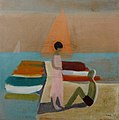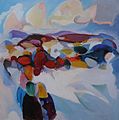Willi Ulfig
Willi Ulfig (born November 26, 1910 in Breslau ; † February 5, 1983 in Regensburg ) was a German painter and graphic artist.
Life
After studying at the Breslau School of Applied Arts (with Peter Kowalski ) and the Art Academy from 1928 to 1932, he spent six months as a scholarship holder at the Art Academy in Italy. After his return, the political situation with the seizure of power by the National Socialists prevented Ulfig from establishing himself as an artist, whose early work was based on Expressionism, which was outlawed at the time . Ulfig was forced to work as a script painter and set designer at the Wroclaw City Theater , was stationed as a soldier in France during World War II (it was here that he got to know and appreciate a French-influenced, elegant variety of expressionist art ) and finally a prisoner of war in Bohemia (CSR). Released in 1945, he began his actual artistic development in the freedom of the later Federal Republic with the arrival in Regensburg (almost all of his paintings before 1945 are lost).
In 1946 he became a member of the newly founded artists' association Donauwaldgruppe ; From 1947 to 1949 he had his first gallery exhibitions, and from the beginning of the 1950s there was increasing artistic success, which made him probably the most important visual artist in Eastern Bavaria in the second half of the 20th century. With study trips to Italy, Greece, Egypt, Ireland, southern France and Holland in the early 1960s, he now expanded his artistic subjects to include the landscapes of Europe. Numerous solo exhibitions at home and abroad, membership in the Munich artists ' cooperative and the Esslingen artists' guild testify to Ulfig's appreciation.
plant
Willi Ulfig's artistic work from the beginnings at the famous Breslau Art Academy to the mature late style of the 1970s is shaped by the examination of the fundamental developments of modernity: the German Expressionists , Cubism and the Fauves , Orphist color theories , and later Informel and Tachism had an impact an extremely sensitive, sensitive artistic nature. Ulfig's uncompromisingly independent pictorial language refers to these currents and transforms them into lyrical, expressive painting of feelings, which gently and melancholy, friendly and deeply mystical describes an inner world that is filled with meditative serenity.
While Ulfig's art was actually only interpreted intrinsically in the image during his lifetime, since the turn of the millennium a new approach to the artistic will of an entire generation of artists to whom Ulfig belongs, known as the Lost Generation, has opened up : a generation that grew out of Expressionism with realistic tendencies towards New Objectivity Wholly independent artistic language, interwoven in the 1920s, was only able to articulate itself regionally after the end of the war - for cultural and political reasons - it is now being rediscovered by art historical science as an important part of German art history of the 20th century.
Typical work, sorted chronologically:
Honors
- 1965 Culture Prize East Bavaria
- 1971 Silver lamb from the city of Brixen
- 1974 Culture Prize of the City of Regensburg
- 2015 Renaming of the Hans Herrmann School in Regensburg to "Willi-Ulfig-Mittelschule"
Literature and solo exhibitions
- Ulfig, Willi . In: Hans Vollmer (Hrsg.): General Lexicon of Fine Artists of the XX. Century. tape 6 , supplements H-Z . EA Seemann, Leipzig 1962, p. 456 .
- Werner Huber: Willi Ulfig - painter of joie de vivre. In: Regensburg Almanach. 1970, pp. 111-114
- Kurt Hofner: Willi Ulfig - or: the magic of color. In: Regensburg Almanach. 1981, pp. 103-112
- Edda Preißl: Everything for art - on the way to Willi Ulfig. In: Festschrift for the 36th Bavarian North Gauge Day . 2006 (Ed. Oberpfälzer Kulturbund), pp. 243–245
- Wilhelm Amann: The young Ulfig. In: Regensburg Almanach. 2010, pp. 154-155
- Reiner Meyer: Willi Ulfig - city views of Regensburg. In: Regensburg Almanach. 2010, pp. 156-167
- Wilhelm Amann: The young Ulfig. In: The Upper Palatinate. Monthly for history, literature, folklore and local studies. 103rd volume (2015), issue 6, pp. 333–349
Willi Ulfig had an almost unmanageable number of solo exhibitions and exhibition participations. The following solo exhibitions were accompanied by catalog books published in print :
- Willi Ulfig. Painting-watercolors-graphics 1945–1974. Exhibition on the occasion of the award of the Culture Prize of the City of Regensburg ( Historisches Museum Regensburg 1974)
- Willi Ulfig. Watercolors 1970–1980. Exhibition on the occasion of the 70th birthday ( Städtische Galerie Regensburg in the Empty Bag 1981)
- Willi Ulfig. A painter on the move - sketches and studies. Exhibition on the artist's 70th birthday ( Ostdeutsche Galerie Regensburg 1981)
- Willi Ulfig 1910-1983. Memorial exhibition organized by the City of Regensburg, the Museum Ostdeutsche Galerie Regensburg and the Art and Trade Association Regensburg (1987)
- Willi Ulfig. Materials - pictures - documents. Exhibition at the Museum für Moderne Kunst Passau (1994), ISBN 3-928109-02-2
- Willi Ulfig 1910-1983. Exhibitions for the 100th birthday. Gallery Danube shopping center Regensburg, Kunstkontor Westnerwacht Regensburg, Municipal Gallery in the Empty Bag Regensburg (2010/2011), ISBN 978-3-00-032478-9
Web links
- http://willi-ulfig.de/hp1461/NACHLASSVERWALTUNG-WILLI-ULFIG-1910-1983.htm?ITServ=CY4cc6aafaX1366c07cb37XY2d72
- http://kulturportal-west-ost.eu/biographies/ulfig-willi-2/
- http://www.regensburg.de/kultur/kulturdatenbank/eintrag/121366
- http://willi-ulfig-ms.schulen2.regensburg.de/index.php/de/schulname
- http://www.bergverein-kallmuenz.de/Maler-in-kallmuenz/29-willy-ulfig.html
- more pictures and drawings by Willi Ulfig
Individual evidence
- ^ Willi Ulfig: Materials - Pictures - Documents. Kunsthaus Ostbayern, ISBN 3-928109-02-2 , pp. 167–168.
- ^ Wilhelm Amann: Willi Ulfig - the fate of an artist in the 20th century. In: Willi Ulfig 1910–1983. Exhibitions for the 100th birthday. P. 10
| personal data | |
|---|---|
| SURNAME | Ulfig, Willi |
| BRIEF DESCRIPTION | German expressionist painter |
| DATE OF BIRTH | November 26, 1910 |
| PLACE OF BIRTH | Wroclaw |
| DATE OF DEATH | 5th February 1983 |
| Place of death | regensburg |











